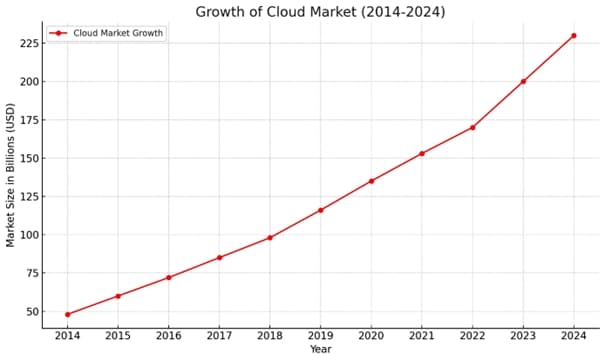Over the last decade, businesses across the globe have increasingly embraced cloud solutions, making the shift from traditional IT infrastructure one of the most defining trends in the tech world. With cloud solutions offering unparalleled scalability, cost-effectiveness, and flexibility, it's no wonder that organizations are choosing to migrate to the cloud to stay competitive in today’s fast-paced, digital-first landscape.
This shift is not just about moving data; it's about redefining business operations, enhancing agility and boosting innovation. From legacy systems to the cloud-first approach, the journey has been rapid, with companies now relying on public and hybrid clouds for everything from hosting applications to processing vast amounts of data.
A Decade of Cloud Market Growth 📈
The data speaks for itself: cloud adoption has been skyrocketing and this trend is only set to continue. Over the past 10 years, the global public cloud market has evolved significantly, with companies progressively migrating more of their IT operations to the cloud.
Here’s a graph showing the growth of the cloud market from 2014 to 2024:

As we can see, the cloud market has grown rapidly, reflecting companies’ increasing reliance on scalable, flexible cloud solutions. In 2024, it’s estimated that the market will be worth over $230 billion. This growth is driven by businesses’ need to reduce operational costs, improve IT flexibility and streamline collaboration.
Why the Shift? 💡
+ Cost Efficiency: Cloud solutions offer a pay-as-you-go model, eliminating expensive upfront costs and reducing overall infrastructure expenses.
+ Scalability: As businesses grow, their cloud solutions can grow with them, ensuring they only pay for what they use.
+ Business Continuity: Cloud platforms provide seamless disaster recovery and zero downtime, making them more reliable than traditional infrastructure.
+ Innovation Enablement: With cloud solutions, companies can adopt new technologies faster, stay ahead of the competition and improve their agility in delivering products and services.
Sources of Transformation: Cloud Solutions in Action 🌐
The shift to cloud solutions has been well-documented by several industry leaders:
Statista reports that the cloud market has grown from $6 billion in 2008 to over $230 billion in 2024 (https://www.statista.com/statistics/510350/worldwide-public-cloud-computing/?utm_source=chatgpt.com).
Gartner predicts that by 2025, 51% of IT spending will be allocated to the cloud, indicating the growing importance of cloud-based infrastructure in businesses (https://www.networkworld.com/article/970698/gartner-by-2025-half-of-enterprise-it-spending-will-be-for-cloud.html?utm_source=chatgpt.com).
According to NetworkWorld, cloud-first strategies are becoming the standard for enterprises, helping them improve agility and optimize operations.
The Future of Cloud Solutions 🔮
As we look to the future, the role of cloud technology will only continue to grow. Companies that have already adopted cloud solutions are now leading the charge in digital transformation, and those still relying on legacy systems will likely face growing pressure to make the move.
The next decade promises to bring even more exciting developments, including advanced cloud-native applications, AI-driven cloud solutions and deeper integrations with edge computing. The move to the cloud is not just a trend; it is the future of business.
Key Takeaways:
The shift to cloud solutions is accelerating as businesses embrace the flexibility, scalability and cost savings they offer.
With cloud adoption, companies are improving business continuity and streamlining operations, all while enhancing their innovative capabilities.
As cloud technologies evolve, businesses must remain agile, leveraging the latest advancements to stay ahead in an increasingly competitive landscape.
